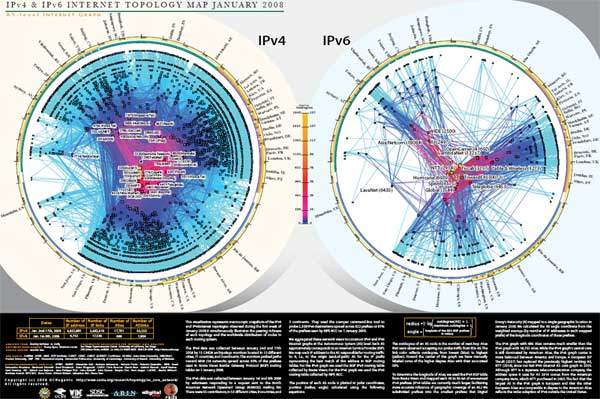This visualization represents macroscopic snapshots of the IPv4 and IPv6Internet topologies observed during the first week of January 2008.It simultaneously illustrates the peering richness of each topology and the worldwide distribution of nodes in each routing system.
The IPv4 data was collected between January 2nd and 17th 2008 by 13 CAIDA archipelago monitors located in 13 different cities, 11 countries, and 3continents. The monitors probed paths toward 48M /24 networks spread across 95% of the prefixes seen in Route Views Border Gateway Protocol (BGP) routing tables on 1 January 2008.
The IPv6 data was collected between January 1st and 8th 2008 by volunteers responding to a request sent to the North American Network Operators’ Group (NANOG) mailing list. There were 56 contributors, in 53 different cities, 9 countries, and 3 continents. They used the scamper command-line tool to probe 2,358 IPv6 destinations spread across 822 prefixes or 81% of the prefixes seen by RIPE NCC on 1 January 2008.
The IPv6 graph with 486 ASes remains much smaller than the IPv4 graph with 18,753 ASes. While the IPv4 graph’s central core is still dominated by American ASes, the IPv6 graph center is more balanced between America and Europe. A European ISP Tiscali (3257) has replaced the previously highest ranking AS, NTT (2914), since our last IPv6 Internet AS core graph in 2005.
Although NTT is a Japanese telecommunication company, the address space it uses for AS 2914 comes from the American company Verio, which NTT purchased in 2000. The fact that the largest AS in the IPv6 graph is European and that the other European ASes are comparable in degree to the American ASes reflects the wider adoption of IPv6 outside the United States.
More info on http://www.caida.org/…/ascore-ipv4-ipv6.200801.poster.pdf

